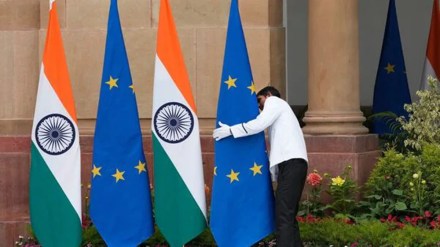As officials from India and European Union (EU) wrapped up their 14th round of negotiations on the proposed free trade agreement (FTA) on Friday, plans are afoot for the visit of Commerce and Industry Minister Piyush Goyal to Brussels later this month before the next round of talks begin.
The Indian negotiators, who had started talks in Brussels on October 6, were joined by Commerce Secretary Rajesh Agrawal in the closing days of the round. Agrawal also met his counterpart in the European Commission (EC) Director General for Trade (DG-Trade) Sabine Weyand during the visit.
The 15th round is expected by the middle of November in New Delhi as both sides aim to finalise the agreement by the end of this year. As the deadline is approaching, the negotiations are taking place every month.
During his visit, Goyal would meet his counterpart the EC Trade Commissioner Maros Sefcovic and other commissioners to nudge the negotiations forward.
In the meantime, intense discussions are ongoing between both the sides. During the 14th round, discussions were held on tariff reductions on some goods, where agreement has remained elusive.
Other areas where the discussions were held include rules of origin, sanitary and phytosanitary measures, technical barriers to trade, services trade, dispute settlement and investments.
The deadline for FTA was set in February by both sides when president of the EC Ursula von der Leyen visited India with the full college of commissioners.
In June 2022, India and the EU resumed negotiations for a comprehensive FTA, an investment protection agreement and a pact on geographical indications, after a gap of over eight years. It was stalled in 2013 due to differences on the level of opening up markets.
Besides demanding significant duty cuts in automobiles and medical devices, the EU wants tax reduction in other products like wine, spirits, meat, poultry, and a strong intellectual property regime.
India’s demands in the negotiations include duty free access to its labour intensive imports and emerging sectors like auto, electronics. Another concern for India in the negotiations is the imposition of carbon tax by the EU on imports of steel, aluminium, cement and fertilisers from January 26. The tax imposed under the Carbon Border Adjustment Mechanism (CBAM) could put another barrier to India’s exports while tariff barriers are brought down further.
The FTA covers 23 policy areas or chapters, including trade in goods, trade in services, investment, sanitary and phytosanitary measures, technical barriers to trade, trade remedies, rules of origin, customs and trade facilitation, competition, trade defence, government procurement, dispute settlement, intellectual property rights, geographical indications, and sustainable development.
The FTA is crucial as the 27-member bloc is the biggest trading partner of India with bilateral merchandise trade at $136.2 billion, though the US remains the biggest market. Indian exports to EU stood at $75.8 billion, while imports were $60.6 billion in 2024-25. Both sides also have a very robust services trade, which stood at $70 billion in 2023. India has a surplus of $ 9.25 billion.
